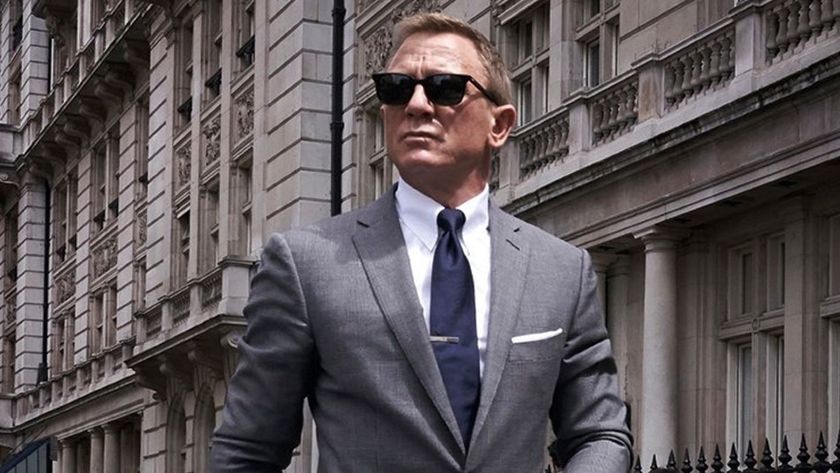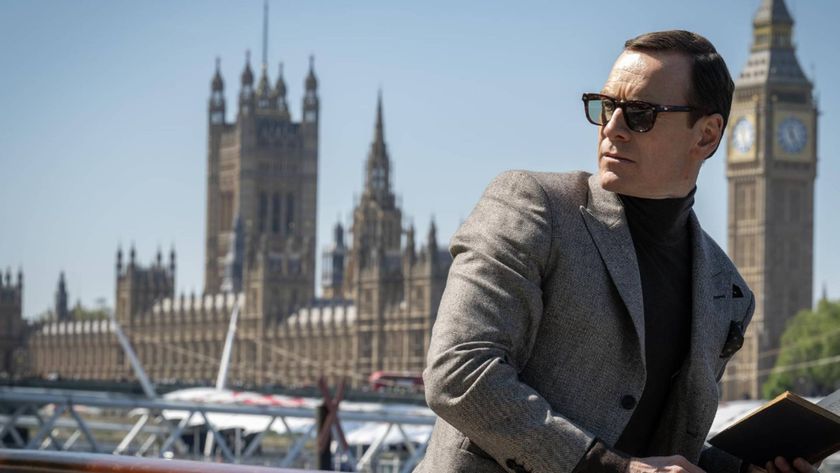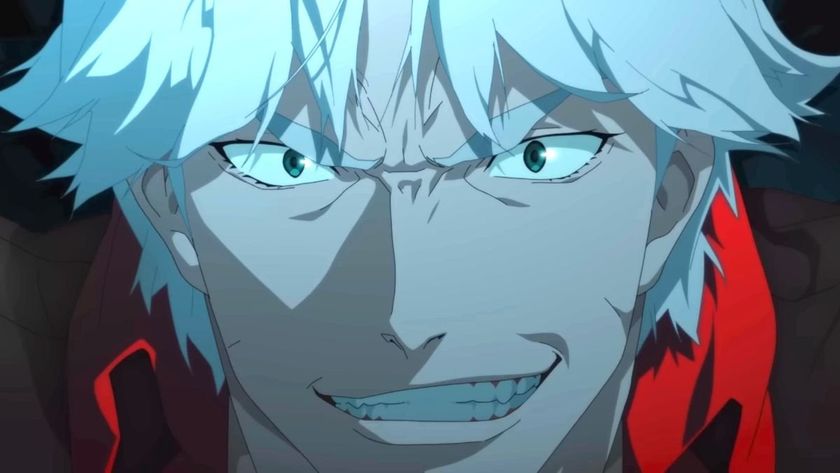Bond Never Dies
The 18th Bond movie in 35 years is the most ambitious of them all – and also looks likely to be the most successful. Yet its production was riddled with tension, rows and controversial hair styling. Garth Pearce, author of The Making Of Tomorrow Never Dies, brings us his exclusive on-set report.
1 April 1997
The first official day of filming at the new James Bond studios, in the unlikely location of a former Kwik Save warehouse at Frogmore, Hertfordshire. Perhaps it’s fitting that today is April Fool’s Day.
The star, Pierce Brosnan, has flu. The script is being hastily rewritten, page by page. The villain, Jonathan Pryce, is having second thoughts about taking the role. Casting is far from final. Anything else? Oh yes, director Roger Spottiswoode has already had to part with a case of champagne and a note of apology after a fall-out with his highly-rated head of special effects, Chris Corbould.
Producer Michael G Wilson gives a disarmingly honest appraisal. “I feel trepidation. Getting it all planned out and the script right has been a major problem. Usually, if the script isn’t right, you just postpone the picture. But we can’t do that. There is a release date, and everyone has agreed to do it. MGM/UA said, “It is very important to us. Please do it.” We have never been under so much pressure.”
4 April 1997
Dame Judi Dench, back as M, wrestles with dialogue written only three days before. She has arrived back from two weeks’ holiday in Barbados with actor husband Michael Williams. When she’s got the script word-perfect, she’s told: “Forget that… now try this.” A theatre veteran, she still feels uneasy on film sets – and this is too much. Judi is a consummate professional, but there are tears in private.
I cannot say that this is a good experience,” she says between endless takes. “I am not at all happy with the situation.”
Director Spottiswoode wears the appearance of a stern university lecturer, and his sharp, acerbic manner is an acquired taste. Continuity woman June Randall, who has already worked on ten of the Bond films, decides she doesn’t want to acquire it. She resigns. She is persuaded to stay on by a concerned Barbara Broccoli, who at 37 is almost as old as her late father’s succession of Bond films.
Sign up for the Total Film Newsletter
Bringing all the latest movie news, features, and reviews to your inbox
Pierce Brosnan, dosing himself with antibiotics in his luxury trailer, has reason to be concerned. Spottiswoode called in a team of writers when he signed on as director at the end of last year. A major rewrite of the script was ordered, leaving its creator, Bruce Feirstein, sidelined after he’d already put in six months’ work on the project. Then, on 18 March of this year, Brosnan read the new script and delivered a succinct judgement: “It’s shit.” Three days later, Feirstein took a phone call from Jeff Kleeman, senior vice-president of production at United Artists. Kleeman’s message was simple: “We want you back.”
Feirstein couldn’t resist. Now, a week later, he sits just 100 yards from the star’s trailer, his fingers hovering over a word processor while he repeatedly replays Alanis Morissette’s Ironic. He’s inspired, he says, both by the words and the music. He is also moved to observe, “I should have said ‘No’ to coming back. All I am thinking now is ‘Will I ever fix it?’’’
The drama of the situation has left Brosnan shaken and stirred. His day started in a meeting with producers Barbara Broccoli and Michael G Wilson. “I said that it is inappropriate at this stage of filming that we should be in a fragile state about a script which is not locked down,” he says, with remarkable diplomacy. “It is not articulate or cohesive enough.”
3 May 1997
Teri Hatcher is frowning. She doesn’t like the hairstyle selected for her character – Paris, wife of villain Elliot Carter. Her favourite make-up is also not available. She prefers to remain in her trailer, in curlers and dressing gown. Besides, she is three months’ pregnant: a new version of a lavish £4,000 dress is being made to accommodate her growing bulge. Outside, crew and stars mingle at the start of a night shoot at the IBM offices in East Bedfont, Surrey. The building is doubling for Carver’s German headquarters.
Teri wasn’t first choice for the part. Casting director Debbie McWilliams selected Italian actress Monica Ramichi, heartily endorsed by Brosnan. Hatcher’s appointment, combined with the casting choices of director Spottiswoode, has left Debbie feeling frustrated. “The director has questioned virtually every piece of casting so far,” she says. “Initially, he even wanted a new M and Moneypenny [Samantha Bond]. This is one job to which I’ll be happy to say goodbye.”
Teri arrived on 23 April to film her first scene – in bed with Brosnan at Stokes Poges Golf Club, Buckinghamshire. Like nearly all the locations in the film, it was doubling for somewhere else, this time a hotel room in Hamburg. Teri complained that his stubble burned her cheeks during kissing. Later she took revenge…
Paris, a former girlfriend of Bond, meets him again at her husband’s media party and slaps his face. There is one take after another, each slap harder than the last, until Brosnan needs an ice pack to combat the fast-spreading redness.
“I enjoyed that,” says Teri.
Pierce, meanwhile, is having little fun. “She has acquitted herself grandly in many ways,” he says. “I am sure she will learn, as she goes on, that a bit of humanity and a bit of grace and a bit of charm goes a long way.”
20 May 1997
Bangkok is harsh and baking. The sun burns exposed backs of necks and turns the crew’s limbs to lead. Pierce Brosnan sits under a white umbrella, like a Victorian grandee. He has filmed in this city before, on Around The World In 80 Days, and knows that the sweating heat and traffic fumes combine to make chests tighten and eyes water. “Welcome to the arsehole of the world,” he says, by way of greeting. We’re on the roof of the Sinn Sathorn Building, 43 storeys up. Brosnan’s scene with Michelle Yeoh is done in short takes as he fires a machinegun to aid his escape from Elliot Carver’s Saigon base. Again, it’s one country standing in for another. Bond flees by leaping onto a vast banner of Carver’s face and tearing through it in a breakneck descent to ground level.
The mood’s uncertain amid the heat. The crew has been working long and arduous hours, and, back in New York, newspaper stories are emerging about discontent and an increasingly frosty relationship between director Spottiswoode and writer Feirstein.
The story turns out to be true. The two are no longer speaking. Feirstein sits in his air-conditioned room at the Shangri-La Hotel, writing scenes against the clock. He talks about his situation, but his views are off the record – a great pity. For now he’s using producer Michael G Wilson as his go-between.
It’s left to Michelle Yeoh, a big-name veteran of Asian action films, to bring humour to the situation. “Hong Kong films are very well known for being haphazard. The script is never ready, it gets handed to you on set, they are always changing things and sometimes the writer is still writing things on set. So I’ve felt right at home with this from the moment I started!”
11 June 1997
Just as we’re wondering how this film is going to meet its completion deadline of 5 September, there is a sudden and dramatic transformation. Jonathan Pryce, who has not been needed in Thailand, arrives fresh to deliver a key speech to a roomful of extras in Stage B at Frogmore, now dressed up to be Carver’s News Room.
He stands at a podium on a black stage fringed with blue fluorescent light. His speech takes little more than two minutes, but it’s delivered with the benefit of 25 years of experience. It lifts the entire atmosphere, earning a round of applause from the crew.
Some of the results from Bangkok are being pieced together by the fast-editing system – set up in an attempt to make best use of the diminishing time. They look excellent. Brosnan’s personal support for Spottiswoode is showing signs of paying off. The mood on set is changing from sullen acceptance to something more upbeat and positive: people can see that the script rewrites are working. Pryce is happier too. He says, “I now feel that we’re getting close to making a very good film.”
24 July 1997
A stunningly realistic Vietnamese street scene has been created over three months at Frogmore for one of the most important stunts of the film. Motorbike expert Jean Pierre Goy is astride the BMW R1200 C cruiser, feeling its weight, going through the timing in his mind. He has to hit 62mph in 5.8 seconds, driving up a ramp that rises 45 feet. Get it right and he’ll leap the street from one building top to another. Get it wrong…
He gets it right, watched by carpenters, electricians, caterers, the writer and the producer. Everyone cheers wildly. It’s now impossible not to notice the optimism, the burgeoning team spirit. More importantly, everyone is speaking to everyone else.
The bike jump is one of many stunts set up by co-ordinator Dickie Beer and filmed with expertise and good humour by second-unit director Vic Armstrong. Vic, who executed Harrison Ford’s big action scenes in all three Indiana Jones films, has won the respect of the crew with a superb succession of large, impressive and safe stunt scenes, scenes which will make up around half the running time of the final film.
Word has it that he and writer Feirstein have performed the equivalent of destroying the iceberg before it can sink the Titanic, then going on to tow the liner to safety.
1 September 1997
Bitter sadness at the famous 007 Stage at Pinewood Studios, Buckinghamshire, where they’re filming the final scenes of the production. News has reached the unit that Princess Diana and Dodi Fayed, due on set today for a secret and informal visit, have been killed in a car crash in Paris. Dodi was a close friend of producer Barbara Broccoli, and she’s inconsolable. Just at the point Tomorrow looks set to fulfil its potential, this is a tragedy so enormous that it eclipses everything. Brosnan says, “It puts everything into perspective, doesn’t it?”
October 1997
Tomorrow Never Dies has record audience-approval ratings at its first test screening. Bond prepares to live happily ever after...
The Total Film team are made up of the finest minds in all of film journalism. They are: Editor Jane Crowther, Deputy Editor Matt Maytum, Reviews Ed Matthew Leyland, News Editor Jordan Farley, and Online Editor Emily Murray. Expect exclusive news, reviews, features, and more from the team behind the smarter movie magazine.













